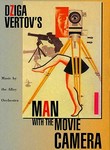 Can a 1929 film made in Russia have anything to teach a beginning filmmaker today? That question was on my mind today when sat down to watch Dziga Vertov’s film, Man With A Movie Camera. The mere fact that you can instant-play the film on Netflix 81 years after it’s release is a clue. This film wasn’t simply trying to show life: its stated intent, shown in brief subtitles that occur mainly at the beginning of the film, is to create a language of film, a cinema without intertitles, without scenario (story), and without actors. In short, it was an act of film rebellion, very much in keeping with the rebellion that he was part of in the fledgling Soviet Union.
Can a 1929 film made in Russia have anything to teach a beginning filmmaker today? That question was on my mind today when sat down to watch Dziga Vertov’s film, Man With A Movie Camera. The mere fact that you can instant-play the film on Netflix 81 years after it’s release is a clue. This film wasn’t simply trying to show life: its stated intent, shown in brief subtitles that occur mainly at the beginning of the film, is to create a language of film, a cinema without intertitles, without scenario (story), and without actors. In short, it was an act of film rebellion, very much in keeping with the rebellion that he was part of in the fledgling Soviet Union.
Synopsis: Dziga Vertov trains his mechanical eye on ordinary life, composing a visual symphony from a series of carefully paced sequences. A woman rising, streetcars passing, carriages riding down busy streets, athletes performing, audiences watching and many more scenes are explored in slow motion, fast motion, split screen, and superimposed sequences, techniques that are still in use today. Further, he includes himself (or another cameraman) as a character in the film, as the observer and participant in modern life.
Story Structure: Basically when is film is called “experimental,” that means it doesn’t have a traditional story. What that means in this film, is that it simply shows life unfolding in a series of tightly edited sequences, which are cut to music, not unlike Koyaanisqatsi and Baraka would be cut many years later. We see a range of human behavior, from waking up, to a funeral procession. An almost comedic sequence shows one couple signing a marriage contract, followed by an unhappy couple signing a divorce contract. The whole thing is strung together with numerous transportation sequences of trains, streetcars, horse-drawn carriages, and automobiles, on which the camera is sometimes mounted for tracking shots.
Cinematography: First revelation is that 1929 cameras were portable! That caught me by surprise. I always thought the first cameras were huge ponderous beasts that were virtually immobile, but not so. The man with the movie camera is everywhere in this film, with his boombox-sized camera mounted on a wooden tripod, slung comfortably over his shoulder. Lots of special in-cemra effects: for example, there’s lovely fast-motion sequences of clouds moving rapidly over a bridge. There’s a special effect in which people dissolve into a scene that is empty until the person dissolves into it. The film must have been at least a little scandalous in it’s day in filming topless women in mud baths. You get the sense that the filmmaker was very confident in pursuit of his images.
Editing: Split screen technique deployed to show man with camera towering over masses of people. Freeze frame action. There’s even the most basic kind of animation in this film, in a comical sequence that shows the film camera cranking itself and dancing, spider like, on its tripod legs. There’s even a pile of dead lobsters with one animated by hand crawling that’s quite freaky. We see pictures of Vertov’s wife editing the film, which are intercut with images of sewing machines, referencing the metaphor of editor as stitching together reality. The role of the filmmaker is ever present in this film. Rapid fire image sequences are at one point intercut with a blinking eye, cut with blinds opening and closing and finally the lens of the camera with it’s iris opening and closing.
Music and Sound: This of course was a silent film, but it’s not silent in that an orchestra would perform with the films of the day. The filmmaker left notes about how the score should be performed, and the version I saw noted that these notes were followed in the production. What we see a lot is that the musical score is fast and bubbly at times, in which editing matches the score (or vice versa). Other times it slows down, and the pace of visuals matches that. There are basic sound effects – such as a pan being hit every time a machine stamps out a widget.
What I learned about filmmaking from this film is that filmmakers have been pressing the limits of what a camera could do from the very beginning. And that the more filmmaking changes, the more it stays the same. Many of the techniques that we use today go back to the very beginning of filmmaking.